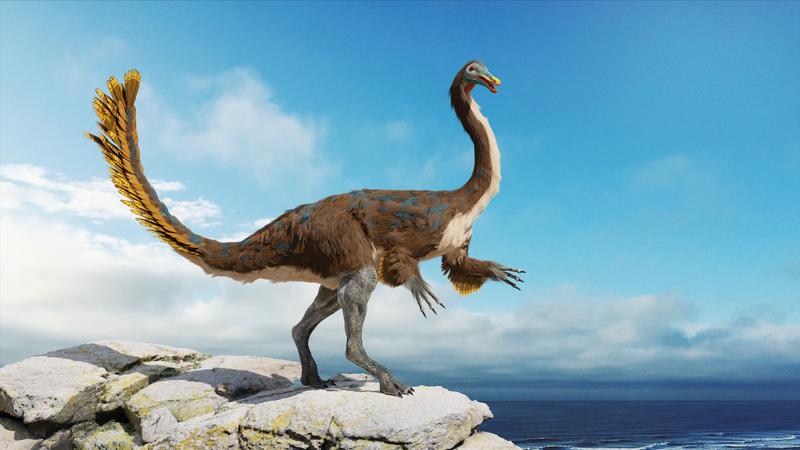FOSSILS REVEAL A 100-MILLION-YEAR-OLD RELATIONSHIP BETWEEN DINOSAURS AND BEETLES

FOSSILS REVEAL A 100-MILLION-YEAR-OLD RELATIONSHIP BETWEEN DINOSAURS AND BEETLES
A remarkable study shows how beetles once fed on the feathers of dinosaurs
Published: 19 April 2023
Share this article
New fossils in amber have revealed that beetles fed on the feathers of dinosaurs about 105 million years ago, showing a symbiotic relationship of one-sided or mutual benefit. The study has been published this week in Proceedings of the National Academy of Sciences of the United States of America.*
The main fossil amber piece studied, from the Spanish locality of San Just (Teruel), contained larval moults of small beetle larvae tightly surrounded by portions of downy feathers. The feathers belonged to an unknown theropod dinosaur, perhaps like the one rendered above, either avian (‘bird-like’) or non-avian, as both types of theropods lived during the Early Cretaceous and shared often indistinguishable feather types. However, the studied feathers did not belong to modern birds since the group appeared about 30 million years later in the fossil record, during the Late Cretaceous.

Vertebrates and arthropods have coexisted for more than 500 million years, and their interactions throughout deep time are thought to have critically shaped their evolutionary history, leading to coevolution. In modern ecosystems, examples of these diverse and complex ecological relationships include ticks infesting cattle, frogs capturing insects with acrobatic tongues, and barnacles growing on the skin of whales. Nevertheless, evidence of arthropod-vertebrate relationships is extremely rare in the fossil record.
In this new study, the larval moults preserved in the amber were identified as related to modern skin beetles, or dermestids. Dermestid beetles are infamous pests of stored products or dried museum collections, feeding on organic materials that are hard for other organisms to digest such as natural fibres. However, dermestids also play a key role in recycling organic matter in the natural environment, and often inhabit the nests of birds and mammals, where feathers, hair, or skin accumulate.
‘In our samples, some of the feather portions and other remains – including minute fossil faeces, or coprolites – are in intimate contact with the moults attributed to dermestid beetles and show occasional damage and/or signs of decay. This is hard evidence that the fossil beetles almost certainly fed on the feathers and that these were detached from the host,’ explains Dr Enrique Peñalver, from the Geological and Mining Institute of Spain of the Spanish National Research Council (CN IGME-CSIC) and lead author of the study.
‘The beetle larvae lived −feeding, defecating, moulting− in accumulated feathers on or close to a resin-producing tree, probably in a nest setting. A flow of resin serendipitously captured that association and preserved it for millions of years.’
(*) The paper “Symbiosis between Cretaceous dinosaurs and feather-feeding beetles” is published as open access in the journal Proceedings of the National Academy of Sciences of the United States of America (=PNAS). DOI: https://doi.org/10.1073/pnas.2217872120.
PICTURE CAPTIONS
1st image: Gallimimus, feathered theropod dinosaur that lived during the Late Cretaceous period (3d science render) (credit Shutterstock)
2nd image: Isolated moult of the feather-feeding beetle larva found in the Spanish amber outcrop of Rábago/El Soplao, with detail of its powerful mandibles (left). Length of the moult is less than two millimetres (Image credit: CN IGME-CSIC).















